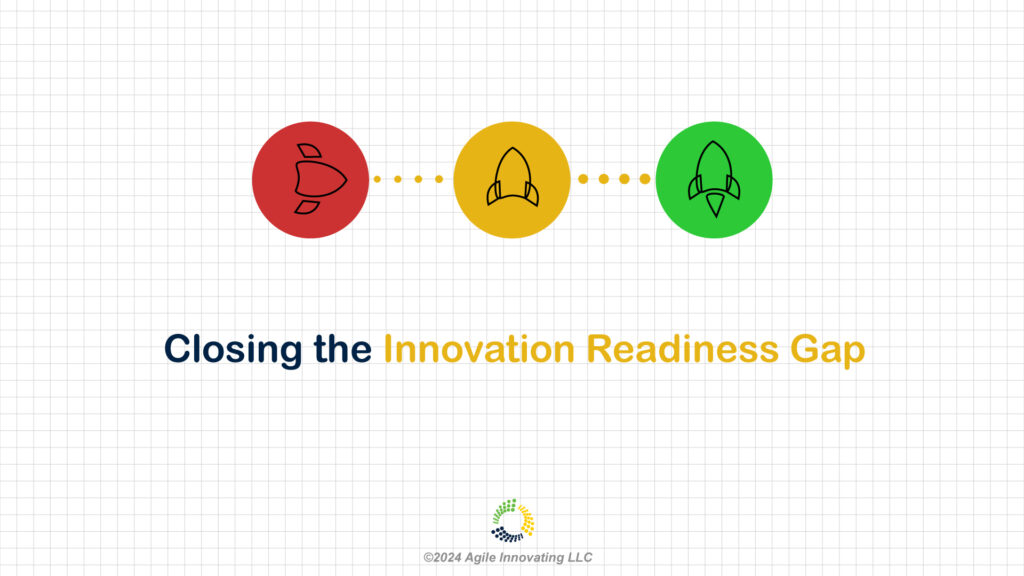
This edition of the 𝘼𝙜𝙞𝙡𝙚 𝙄𝙣𝙣𝙤𝙫𝙖𝙩𝙞𝙣𝙜 ™ Newsletter is for Business Leaders who are investing in Innovation Projects but not getting the project results or business outcomes they need.
In their “2021 Most Innovative Companies” report, the Boston Consulting Group introduced the idea of an Innovation Readiness Gap. The Readiness Gap was defined as the lack of systemic ability to achieve the aspirational goals of a business’s innovation programs and projects. BCG found that 80% of the companies in their study who were investing in innovation were being held back in achieving their goals by this gap.
BCG quantified the Gap based upon two areas of evaluation: (1) Innovation infra-structure, and (2) Innovation Practices. In this edition of our newsletter, we identify the Innovation Capabilities that are necessary to close the Readiness Gap.
Innovation Elements
A business’s innovation practices often make use of one or more of the following, well known, seven elements.
1. Factors – Volume of ideas; Voice of the Customer
2. Postulates – The admonition while innovating to “fail early, fail fast, fail often”
3. Practices – Human Centered Design (Design Thinking); Business Model Canvas
4. Processes – Stage / Gate NPD; Lean Manufacturing
5. Methods – Jobs-To-Be-Done (JTBD); Lean Start-Up; Agile Development
6. Skills – imagination; creativity
7. Magic – good luck; serendipity
Each of these elements, and their practical embodiments, has potential value in an Innovation Program. But companies can struggle with knowing which elements to use, when, and how. In addition, there is little actionable guidance as to how to link the outcomes of one element to other elements that are being utilized. This can create disjoint and disconnected innovation efforts which maintain the Readiness Gap rather than close it.
Innovation Capabilities
A capability is characterized by both knowledge and execution skill. A capability is knowing “What to do”, “When to do it”, “”How to do it”, and “Why”, and having the capacity to take action towards accomplishing a goal.
There are eight organizational capabilities that are associated with high performance Innovation Programs. These capabilities are grounded in the ability to:
1. Make sense of the Status Quo
2. Generate impetus and momentum for change
3. Envision and articulate the impact of potential change
4. Find, define, and solve problems-worth-solving
5. Develop new and better solutions
6. Introduce new and better solutions
7. Orchestrate the adoption of new and better solutions
8. Manage the seven core capabilities as a business system serving a common purpose
Closing the Innovation Readiness Gap depends upon developing and making these eight capabilities effective.
Conclusion
Developing and making effective use of the Eight Innovation Capabilities will likely include utilizing some of the seven innovation elements. But building capability is not just learning how to use, and then systematizing, the seven elements. The seven elements, by themselves, form an incomplete picture of what it takes to close the Readiness Gap.
Capability is a knowledge base, skill set, and capacity that includes more than applying a sub-set of the seven elements. We’ll explore each of the eight capabilities and how to develop them in future editions of the 𝘼𝙜𝙞𝙡𝙚 𝙄𝙣𝙣𝙤𝙫𝙖𝙩𝙞𝙣𝙜 ™ Newsletter.
If you want more information on developing the Eight Innovation Capabilities and how to use them to close your Innovation Readiness Gap, please contact us at [email protected] , or schedule an introductory meeting at https://calendly.com/kevinafee/30min
🌱
Capabilities
Knowledge, skills, capacity
Drive Innovation
-Innovation Haiku, Kevin A Fee, May 28, 2024
